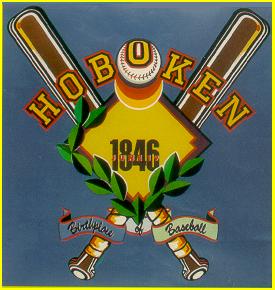 |
 Hoboken and the Beginnings of Baseball
Hoboken and the Beginnings of Baseball
By Nicholas Acocella
Part 1 - Before Baseball, They Played...
The unadorned fact is that no one "invented" baseball. Not, at least, the way Edison invented the incandescent lamp, or, probably a better analogy, the way Naismith invented basketball.
People have been swatting balls with bats for recreation since the ancient Egyptians. (There is a 3,500-year-old mural of Pharaoh Thotmes III hitting fungoes to two of his priests in the Temple of Deir-er-Bahari. Most commentators ascribe a religious significance to what they are doing, but it is altogether possible that the clergymen just needed the practice.) People have been playing ball games on these shores at least since Christmas Day, 1621, when William Bradford, the Governor of Massachusetts Bay Colony, reprimanded some young men for playing stool ball. (The game involved two bases, designated by stools, between which players ran alter hitting the ball with bare hands.)
More sophisticated was rounders. Originally a children's game, rounders was played by two teams of unspecified size. Each team remained at bat for as long as its players, wielding an 18-inch truncheon one-handed, hit safely in an effort to advance runners through four bases to score a "rounder." (The "bases" were posts driven into the ground about 40 feet apart.) The opponents scattered about the field and tried to retire the hitting team's players either by catching a batted ball on the fly or on one bounce, or by hitting a runner with the ball while he was off base. This practice, known as "plugging" or "soaking," was not so painful as might appear, since the ball was stuffed with rags.
Rounders evolved into town ball, an informal folk game, for the most part, with rules that varied from place to place. Fairly common were the prevalence of a square field, the batter's "stand" between the first and fourth base, the "back game" that allowed hitting the ball behind the batter (as in cricket), and plugging/soaking. One variation awarded a contest to the team with the most total bases, rather than the most runs scored. Another was the number of players -- which depended, as often as not, on how many people were still sober at the annual Fourth of July picnic when the game began.
Rounders, town ball, round ball, and base ball (or simply base) became virtually indistinguishable terms referring to a variety of similar but locally delineated games played throughout the 18th century. John Newberry's A Pretty Little Pocket-Book, first published in London in 1744, and reprinted in the colonies as early as 1762, includes a woodcut illustration and a description (rhymed, no less) and of what the author calls Base-Ball, but is almost certainly a form of rounders. The first written mention of an actual contest is by George Ewing, one of Washington's troops at Valley Forge, who wrote in his diary on April 7, 1778: "exercised in the afternoon in the intervals played base."
By the 1840s, the most common bat and ball sport was the Massachusetts Game, played by teams of 10 to 14 players on a 60-foot square field with bases at the corners. As in rounders and town ball, the batter stood between the first and fourth bases, there was no foul territory, and soaking was still the order of the day. Differences with older folk games included overhand pitching from a distance of 30 feet, one out to retire the side, the addition of three strikes for an out, no one-bounce outs on the fly balls, and a specified number of runs scored to determine the winner.


|
|
 |